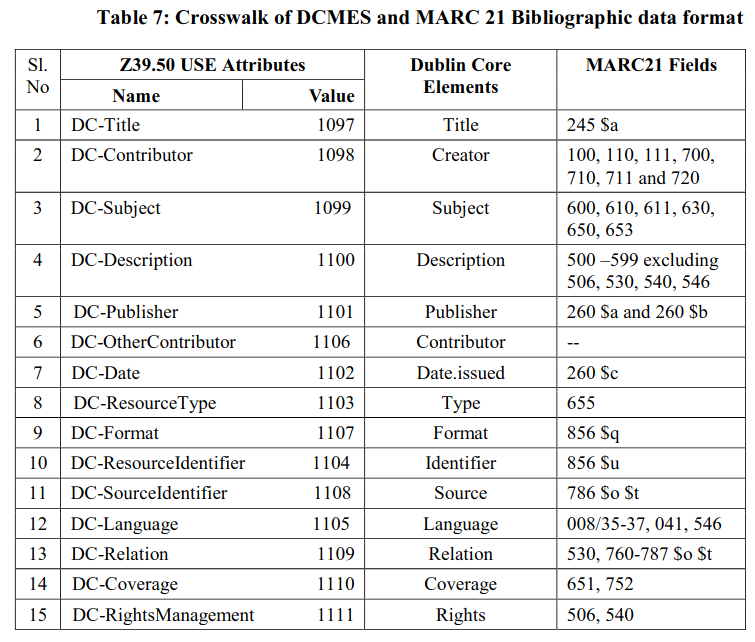1.8 Metadata: Crosswalks and Interoperability Standards
Interoperability is the ability of multiple systems, with different hardware and software platforms, data structures, and interfaces, to exchange data with minimal loss of content functionality. There are two approaches to interoperability—cross-system search and metadata harvesting. The Z39.50 protocol is commonly used for cross-collection search. The Z39.50 client (called origin) maps search syntaxes to a common set of search attributes for extracting information from Z39.50 server (called target). Open Archives Initiative63 is a protocol for metadata harvesting, which allows all partners to translate their native metadata to a common core set of elements and expose those for harvesting. A search service then gathers the metadata sets into a central index to allow cross-repository searching regardless of the metadata formats used by participating repositories. Metadata crosswalks facilitate the interoperability and exchange of metadata. A crosswalk is a mapping of the elements, semantics and syntax from one metadata schema to those of another. It allows metadata created by one community to be used by another group that employs a different metadata standard. The Library of Congress' Network Development and MARC Standards Office is developing a framework for working with MARC data in a XML environment. This framework is intended to be flexible and extensible to allow users to work with MARC data in ways specific to their needs. The framework will contain many components such as schemas, style sheets, and software tools developed and maintained by the Library of Congress. MARC-XML could potentially be used for representing a complete MARC record in XML, as an extension schema to METS (Metadata Encoding and Transmission Standard), to represent metadata for OAI harvesting, for original resource description in XML syntax and for metadata in XML that may be packaged with an electronic resource. A crosswalk mapping of Dublin Core, MARC 21 and Z 39.50 attributes is illustrated here to make it clear to you.

Resource description area is dominated by NISO standards, ISO standards and standards developed by Library of Congress. The major standards developed by NISO and ISO are -
- Z39.91 (Stage Collection Description Specification)
- Z39.92 (Stage Information Retrieval Service Description Specification)
- Z39.85 (The Dublin Core Metadata Element Set)
- Z39.86 (Specifications for the Digital Talking Book)
- Z39.87 (Data Dictionary - Technical Metadata for Digital Still Images)
- ISO 15836:2003(Information and documentation - The Dublin Core metadata element set)
- ISO 17933:2000 (GEDI -- Generic Electronic Document Interchange)
In the area of metadata interoperability ISO 2709 and ANSI/NISO Z 39.2 (Information Interchange Format) standards played a historic role and till date ISO-2709 is considered as a mandatory standard in the library world for import and export of cataloguing data. The standards developed by Library of Congress are also considered as important milestones in resource description area such as
- MODS (Metadata Object Description Standard64) - XML markup for selected metadata from existing MARC 21 records as well as original resource description (developed by Library of Congress)
- MADS (Metadata Authority Description Standard65) - XML markup for selected authority data from MARC21 records as well as original authority data (developed by Library of Congress)
- METS (Metadata Encoding andTransmission Standard66) - Structure for encoding descriptive, administrative, and structural metadata (developed by Library of Congress)
METS (Metadata Encoding and Transmission Standard) is a standard for encoding metadata within prescribed format. It contains descriptive and administrative elements of its own, but a major purpose of METS is to provide structure to accommodate other metadata schemas for exchange or delivery. It ensures that different digital objects can be described and linked together in a record to develop structure of description for complex digital resources (for example different components of a digitized book such as bibliographic data, images, transcribed text, maps etc may be described by using generic and domain-specific metadata schemas and finally packed in METS format). METS has its origin in a large scale digitization project Making of America II (MOA2), sponsored by the US Digital Library Federation. It is now maintained by the US Library of Congress (METS version 1.1 was released in 2001; the current version is 1.5, released in 2005). A MODS (Metadata Object Description Standard), on the other hand, is a metadata schema for encoding information about library resources (particularly books). It is based on a subset of the MARC 21 standard (MARC 21 Bibliographic Format) and it expresses MARC-compatible metadata format in XML and by using language-based element names. The first (draft) version 1.0 was released in 2002. The current version is 3.2, published in 2006. It is maintained by the US Library of Congress and is often used with METS as a descriptive metadata structure standard which means that METS acts as metadata wrappers and MODS acts as metadata schema for storage or exchange of digital objects. MADS (Metadata Authority Description Standard) is a companion schema to MODS. It is based on MARC 21 Authority format. It aims to support expressing authority format in XML. It deals with headings and cross references ('see' and 'see also' in the library community), including name authority (personal names, corporate names, name/title entries), title authority (title entries, uniform titles), and subject authority (subject, genres, and geographic places). MODS and MADS are often used in harmony to describe bibliographic and authority datasets in XML and METS provides a metadata wrapper to store, deliver and sharing of resource description datasets.
